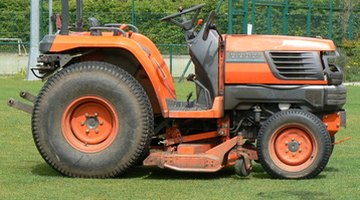How do I Troubleshoot a Hydrostatic Kubota Tractor?
A Hydrostatic Kubota Tractor is one that uses a hydrostatic transmission system. This translates to a variable-displacement pump and displacement motor operating together in a closed circuit. Kubota, a well-respected name in tractors, manufacture more than 80 models.

Things You Will Need
- Small wire brush
- Pocketknife
- Volt meter
Tip
Clean the tractor's radiator at least once a day during windy and dusty conditions, Always use a blend of antifreeze (coolant) and distilled water in the radiator. Make sure your battery is in good working order with enough voltage. Use a volt meter to see if the battery has a reading of at least 12 volts. Sometimes water can get into the fuel system. If this happens, you can remove the glow plugs and crank the engine by hand to expel the water. Make sure to replace the engine oil and filter is this does occur.
Warning
Use eye protection as necessary when working around batteries.
Although these tractors are sturdy and dependable, as with most heavy farm equipment, breakdowns can happen. Before calling out a mechanic, there are a number of troubleshooting steps you can take.
-
Check to see if there is any smoke coming from the exhaust when you attempt to start the tractor. If the engine will not start and there is no smoke at all, it could mean that no fuel is reaching the engine. Make sure there is fuel in the tank. Check the air filter for any dirt and sediment. Clean the filter out or replace if necessary.
-
Check for a blown fuse link if the electrical components are not working. The fusible link is a loop of wire located next to the starter. Replace if necessary.
-
Check to see if the battery post and wires are dirty. Remove the cables attached to the battery, making sure to lift the negative cable off first. Clean the battery terminal using a small wire toothbrush or a pocketknife. When you replace the cables, make sure to clamp the positive lead first.
-
Blow compressed air through the radiator core if the engine shows signs of overheating. The air flow could be restricted through the radiator. Take care not to bend the metal fins on the radiator when blowing compressed air.
-
Drain the fuel system immediately if you smell gasoline in the tank. Flush out the entire system and replace with the correct diesel fuel. The smell of gasoline mixed in with diesel is usually quite distinctive.
Resources
Writer Bio
Ross Glyn began writing for film and television in 1986. He wrote and directed the film “After The Rain” as well as the play “Soweto's Burning.” He is a member of the Writers Guild Of America, the Screen Actors Guild and the American Federation of Television and Radio Artists. Ross holds a performer's degree from the London Academy of Music and Dramatic Art.
Photo Credits
- tractor image by Alison Bowden from Fotolia.com
- tractor image by Alison Bowden from Fotolia.com
More Articles
- How to Fix a DeWalt Charger
- How to Troubleshoot Brushless Generator Armatures
- How to Fix the Governor Springs on a Weedeater Lawnmower
- How to Troubleshoot a Grasshopper Lawn Mower
- How to Change the Battery for the Ignition on a DCS Gas Grill
- How to Convert a Massey Ferguson 35 From a Generator to an Alternator



